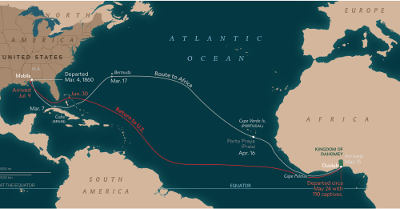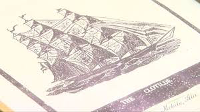|
Wreck of Infamous Slave Ship Clotilda Found, Officials Say
May 24, 2019
Archaeologists are all but certain that they have discovered the remains of the Clotilda, the last remaining ship to sail from Africa to America. The wreck has been found in Mobile Bay. Timothy Meaher, one of Mobile's wealthy elite in the mid-19th Century, is said to have made a bet with a group of other businessmen, from the North, that he could smuggle a ship full of African slaves into Mobile Bay in 1860, right past federal officials. It was the year just before the start of the Civil War, and an 1808 law had outlawed the international slave trade. That law hadn't stopped all such voyages from taking place. Meaher business rivals took the bet, and Meaher went to work. He ordered built a large boat and found a captain, William Foster, willing to sail it on the sly to Ouidah, in what was then the Kingdom of Dahomey and what what is now Benin. It was one of the most notorious of Africa's slave ports. The ship was the Clotilda, and Foster and crew set out from Mobile on March 4, 1860. They sailed by Cuba three days later and reached at Bermuda 10 days after that. The Cape Verde Islands was the next destination, reached on April 16; and the ship and crew landed in Africa on May 15. Nine days later, with 110 men, women, and children onboard, then set sail for the return voyage. This time, the island sightings were few. The Clotilda returned to the waters of Mobile Bay on July 9. The slaves, of course, were crowded into the ship's hold, as was common practice for such voyages. One girl died during the voyage across the notorious Middle Passage. Once the ship reached its destination and the captives had been put in a smaller boat for transport to land, the ship's captain and his crew burned the ship so it would sink into obscurity. Federal officials knew that the ship was coming because Meaher had been outspoken about his plans; what the federal officials didn't know was exactly when the ship would arrive. And when Foster did arrive, he sailed in under cover of darkness and avoided everyone who might have been looking for him and the other people onboard. The Africans who survived the journey and the Civil War initially wanted to return to Africa; they couldn't afford it and so pooled their resources and bought what land they could north of Mobile, near the rural settlement of Plateau, a place they called Africatown. The survivors looked after one another and kept their story alive. One of Some descendants of the survivors continued to live in Africatown and continued to tell their ancestors' stories. The ship remained lost. During a chance low tide in 2018, a local journalist found remains of a large wooden ship. It wasn't the Clotilda, but the discovery did spark interest in finding the infamous ship and, more importantly, funding for the enterprise. Details of the ship's construction emerged, including size and materials. The ship turned out to be atypically built, which helped narrow the field as researchers found more and more wrecks under the water. Knowing that the 86-foot schooner had a 23-foot beam, a 6-foot, 11-inch hold, a 13-foot-long centerboard helped the researchers know where to search. They chose an area of the Mobile River that had not been dredged. What they found matched the Clotilda's dimensions, as well as what were known to be its materials: southern yellow pine planking, white oak frames, and pig iron hull fasteners. What they haven't found so far is anything bearing the name of the ship, but officials from the Alabama Historical Commission are confident that they have found the notorious ship. |
|
Social Studies for Kids
copyright 2002–2024
David White






 the last living survivors of the horrendous journey, Cudjo Lewis, told the story of his life with Zora Neale Hurston, an anthropologist who was more well-known as a fiction author. She wrote a book about Lewis and the Clotilda called Barracoon. Hurston spent many days talking to Lewis in 1927. For a variety of reasons, the book was not published in her lifetime. The book came out in 2018, with Lewis's photo on the cover.
the last living survivors of the horrendous journey, Cudjo Lewis, told the story of his life with Zora Neale Hurston, an anthropologist who was more well-known as a fiction author. She wrote a book about Lewis and the Clotilda called Barracoon. Hurston spent many days talking to Lewis in 1927. For a variety of reasons, the book was not published in her lifetime. The book came out in 2018, with Lewis's photo on the cover.

